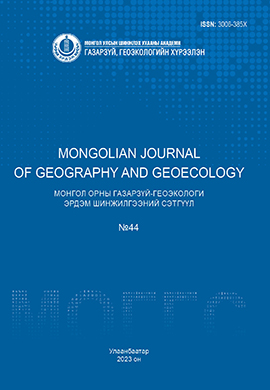Object-based classification of indices derived from optical and radar datasets
DOI:
https://doi.org/10.5564/mjgg.v60i44.2941Keywords:
Sentinel-1, 2, Multiresolution, Quadtree, Segmentation, ClassificationAbstract
Since the launch of the European Space Agency’s Sentinel-1 radar and Sentinel-2 optical satellites, high-resolution multisource datasets have widely been used for land cover classification and other thematic research. The aim of this study was to segment 4 different indices derived from Sentinel-1 and 2 satellite datasets using multisolution and quadtree methods, classify the land cover of the selected area using an object-based classification method, and make a comparison. As a test site, the northwestern part of Khuvsgul Lake was selected, and integrated images acquired from Sentinel-1 and 2 satellites in June 2022 were analyzed. According to the results, the overall accuracy of the classification based on the quadtree segmentation was 99.71%, while the overall accuracy of the classification based on the multisolution segmentation was 98.80%. This finding indicates that using the quadtree method provides better results in determining the land cover types of the selected area.
Оптикийн ба радарын мэдээнээс тооцсон индексүүдийг ашиглан объектод суурилсан ангиллын аргаар газрын бүрхэвчийг ангилах
ХУРААНГУЙ: Европын сансрын агентлаг Sentinel-1 радарын болон Sentinel-2 оптикийн дагуулуудыг хөөргөсөн цагаас эхлэн оронзайн өндөр шийд бүхий нийлмэл мэдээг газрын бүрхэвчийн ангилал болон бусад сэдэвчилсэн судалгаанд өргөнөөр ашиглаж байна. Судалгааны талбайгаар Хөвсгөл нуурын баруун хойд хэсгийг сонгосон бөгөөд дүн шинжилгээнд Sentinel-1, 2 дагуулаас 2022 оны 6-р сард хүлээн авсан мэдээг ашиглав. Энэхүү судалгааны зорилго нь Sentinel-1, 2 дагуулын мэдээг ашиглан тооцоолсон 4 төрлийн индексийг олон шийдэт, куодтри гэсэн 2 өөр аргаар сигментлэн, улмаар сонгосон нутгийн газрын бүрхэвчийг объектод суурилсан ангиллын аргаар ангилж, харьцуулсан дүгнэлтийг хийхэд оршино. Судалгааны хүрээнд, ургамлын нормчилсон дундаж индекс, ургамлын хөрснөөс ялгасан индекс, усны нормчилсон дундаж индекс болон радарын мэдээний туйлшралуудын харьцааг ашиглан ой, ногоон ургамал, халцгай газар, ус гэсэн ангид ангилал хийхийн тулд объектод суурилсан ангиллын аргыг дэвшүүлсэн бөгөөд холимог ангиудыг ялгах зорилгоор янз бүрийн дүрмийг зохиосон болно. Дүрмийн сан нь сонгосон анги тус бүрд тохирсон нөхцөлийг тодорхойлсон, доороосоо дээшээ шаталсан олон шатлал бүхий дүрмүүдээс бүрдэнэ. Судалгаанд ашигласан нарийвчлалын үнэлгээний дүнгээс харахад, куодтри сигментчилэл дээр суурилсан ангиллын ерөнхий нарийвчлал 99.71%, харин олон шийдэт сигментчилэл бүхий ангиллын ерөнхий нарийвчлал 98.80% байлаа. Энэ нь сонгосон нутгийн газрын бүрхэвчийг объектод суурилсан ангиллын аргаар ангилахад, куодтри аргаар сигментлэх нь илүү зохимжтой гэдгийг харуулж байгаа юм.
Түлхүүр үгс: Sentinel-1,2, Олон шийдэт, Куодтри, Сигментчилэл, Ангилал
Downloads
179
References
Д.Амарсайхан, Орчин үеийн газарзүйн мэдээллийн систем, тандан судлалын зарчмууд. 32.8хэв.хуудас, Улаанбаатар хот: Эрдэм хэвлэл, 2019.
Э.Нямжаргал, Д.Амарсайхан, "Газрын бүрхэвчийг пиксел болон объектэд суурилсан аргуудаар ангилан харьцуулсан дүн". Монгол Орны Газарзүй-Геоэкологийн Асуудлууд сэтгүүл, №43, ШУА-ийн Газарзүй-Геоэкологийн хүрээлэн, 2022.
D. Liu and F. Xia, "Assessing object-based classification: advantages and limitations". Remote Sensing Letters, vol. 1, no. 4, pp.187-194, 2010. https://doi.org/10.1080/01431161003743173
R. Weih and N. Riggan, "Object-based classification vs. pixel-based classification: comparativeimportance of multi-resolution imagery", The International Archives of the Photogrammetry, RemoteSensing and Spatial Information Sciences, Vol. XXXVIII-4/C7, 2012.
What is Artificial Intelligence, AlanTuring.net. May 2000. Retrieved 28 August 2017.
eCognition software user guide, Definines Imaging, Germany, 2005.
C. Munyati, "Optimising multiresolution segmentation: delineating savannah vegetation boundaries in the Kruger National Park, South Africa, using Sentinel 2 MSI imagery". International Journal of Remote Sensing, 39:18, 5997-6019, 2018. https://doi.org/10.1080/01431161.2018.1508922
P. Tsai, Y-C. Hu & C-C. Chang, "Novel image authentication scheme based on quadtree segmentation", The Imaging Science Journal, 53:3, 149-162, 2005. https://doi.org/10.1179/136821905X50406
Cheng Fu, Haosheng Huang & Robert Weibel, "Adaptive simplification of GPS trajectories with geographic context - a quadtree-based approach". International Journal of Geographical Information Science, 35:4, 661-688, 2021. https://doi.org/10.1080/13658816.2020.1778003
M. Wulder, S. Franklin, J. White, J. Linke and S. Magnussen, "An accuracy assessment framework for large-area land cover classification products derived from medium-resolution satellite data". International Journal of Remote Sensing, vol. 27, no. 4, pp. 663-683, 2006. https://doi.org/10.1080/01431160500185284
Shihong Du, Zhou Guo, Wanyi Wang, Luo Guo & Juan Nie, "A comparative study of the segmentation of weighted aggregation and multiresolution segmentation". GIScience & Remote Sensing, 53:5, 651-670, 2016. https://doi.org/10.1080/15481603.2016.1215769
Camile Sothe, Cláudia Maria de Almeida, Marcos Benedito Schimalski, Veraldo Liesenberg & Pedro Achanccaray Diaz, "Automatic tuning of segmentation parameters for tree crown delineation with VHR imagery". Geocarto International, 36:19, 2241-2259, 2021 https://doi.org/10.1080/10106049.2019.1690056
Downloads
Published
How to Cite
Issue
Section
License
Copyright (c) 2023 Jargaldalai Enkhtuya, Amarsaikhan Damdinsuren, Enkhjargal Damdinsuren, Tsogzol Gurjav

This work is licensed under a Creative Commons Attribution 4.0 International License.
Copyright on any research article in the Mongolian Journal of Geography and Geoecology is retained by the author(s).
The authors grant the Mongolian Journal of Geography and Geoecology a license to publish the article and identify itself as the original publisher.

Articles in the Mongolian Journal of Geography and Geoecology are Open Access articles published under a Creative Commons Attribution 4.0 International License CC BY.
This license permits use, distribution and reproduction in any medium, provided the original work is properly cited.




